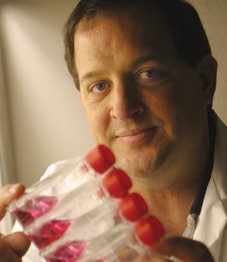Probing differences in heart disease
 |
Fort Worth, TX
5/1/2007
By Rick Waters, '95
Heart disease is the top killer of women in the United States. In fact, 50 percent of women die from cardiovascular disease compared with 4 percent who succumb to breast cancer, according to the National Institute for Health (NIH).
Surprised? There is good reason to be.
Until recently, doctors and researchers were mostly in the dark about heart disease in women. Like the rest of us, they have clung to the long-held notion that it mainly afflicts men. Even research, historically, has been devoted mostly to young and middle-aged white males, yet findings have been applied globally to women and other groups.
One problem: Men and women don’t exhibit the same signs and symptoms. Men tend to develop coronary artery disease around 50. For women, it’s often a decade later. Men typically present with the well-known classic signs – left arm radiation, chest pain, palpitations. Women sometimes experience none of these. Instead, they report less obvious symptoms such as fatigue, shortness of breath and sleep disturbance.
Why?
That’s the question Dennis Cheek, Abell-Hanger Professor of Gerontological Nursing, has been asking for more than two decades, and he thinks he may have a partial answer.
“Since a woman presents differently than a man, deep inside her body, her cells react differently,” he said. “Something fundamentally different must occur at that very basic level. What we’re looking for is some kind of marker — a biological marker — that, when you draw blood, signals risk for developing cardiovascular disease.”
Cheek’s search has taken him to the endothelium, a single layer of cells that line the inside of the heart and blood vessels. It is the body’s second largest organ – covering an area 4,000 to 7,000 square meters, or roughly the area of six tennis courts – yet, as Cheek sees it, the endothelium might be the Rodney Dangerfield of the human body.
For years, researchers believed the organ had little impact on the body’s overall health. Now, they know that it is active in metabolism. It also plays a key role in signaling cardiovascular disease because of its crucial location between the blood and vessel walls.
When functioning correctly, the endothelium produces and releases nitric oxide, which is generated by nitric oxide synthase (NOS), an enzyme that creates chemical reactions inside the body. The nitric oxide relaxes the smooth muscle surrounding the vessel walls, thus dilating arteries. As a result, it reduces blood pressure and aids blood flow.
But as humans age, the endothelial cells lose function and produce smaller amounts of NO. Cheek and other researchers believe this dysfunction likely marks the beginning of atherosclerosis (hardening of the arterial blood vessels) and subsequently heart disease. It is also linked to diabetes, obesity, hypertension and high cholesterol. (For smokers, risk of dysfunction shoots up exponentially.)
“Basically, nitric oxide has a protective effect on the endothelium,” Cheek said. “Therefore, based on its presence or absence in endothelial cells circulating in the blood stream, we could identify women at risk for heart disease. So the genetic expression of endothelial nitric oxide synthase (eNOS mRNA) could be our biomarker.”
The problem is that endothelial cells circulating in the body are difficult to capture in a blood sample. In a milliliter of blood, a researcher might collect only a few. Sometimes none. That means they mostly get weak samples that are too diluted to measure.
Cheek’s work has been to develop a method in vitro (in a test tube) to isolate and measure eNOS mRNA from cells at a given sample size. Cheek and student researchers have used lab-grown female human vascular umbilical cells and diluted them into a series of samples, some as small as a nanogram. Then they have amplified the enzyme in the samples using quantitative real-time polymerase chain reaction, a device that amplifies and makes copies of genetic code.
“Essentially, it works like a copy machine, replicating the genetic code as it goes along, so it can be more easily measured,” he said. “We can go from a single sample to a million in a short period.”
These measurements have helped Cheek determine a dynamic range of values of eNOS mRNA in the small samples, essentially what’s normal, which will give researchers a baseline for future studies. In other words, no matter how diluted a sample is, Cheek’s findings will be the basis for accurate readings. Next up, testing the technique in a blood draw. Cheek and his team have been approved to draw blood from patients at John Peter Smith Hospital in Fort Worth, but he says they’re not quite ready.
“We’re not going to do it until we get some other techniques set,” he said. “But we’ll keep working at it.”
Contact Cheek at d.cheek@tcu.edu
Comment at tcumagazine@tcu.edu
Faculty bio
Dennis Cheek (RN, PhD) has been the Abell-Hanger Professor of Gerontological Nursing in TCU´s Harris College of Nursing and Health Sciences since 2003. He teaches pharmacology at both the graduate and undergraduate level and was the college´s nominee for the Chancellor´s Award for Distinguished Research and Creative Activity in 2005. His research interests include the effects of female steroid sex hormones on coronary artery endothelial cells and the release of pro/anti-inflammatory cytokines and ATP. The author of hundreds of published articles, he was selected in 2002 as Fellow of the American Heart Association and Council on Cardiovascular Nursing. He also was invited in 2000 as a Fellow at the inaugural NIH/NINR Summer Genetic Institute.










